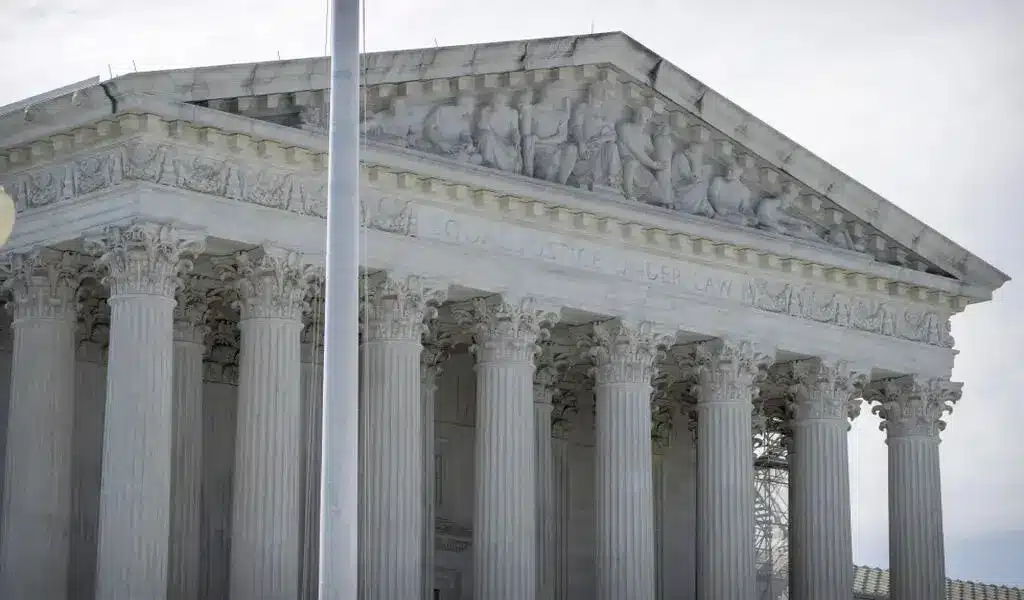News
Building Collapses into Raging River in Southwestern China [Video]
As heavy monsoon rains pummeled areas of China, Chinese authorities have issued a warning of “multiple natural disasters” in the coming month. A weather warning has been issued for most of central and southwestern China, and thousands of people have been evacuated.
In Chongqing, a building toppled into surging floodwaters, while rescuers in Henan province were recorded liberating individuals caught on top of a car in the middle of a flood.
Authorities in China have issued a warning of harsh weather and “multiple natural disasters” in the coming month, as torrential rain has damaged infrastructure and prompted many to flee.
According to the official Xinhua news agency, rain-related disasters were declared in wide swathes of central and southwestern China on Tuesday.
The country will confront “multiple natural disasters in July, including floods, severe convection weather, typhoons, and high temperatures,” according to meteorological authorities.
Workers discovered Tuesday that a closed-off railway bridge on the outskirts of southwestern metropolis Chongqing had collapsed after being “damaged by the impact of mountain torrents,” according to state media CCTV.
According to CCTV, more than 400 emergency professionals have been dispatched to examine the damage and safeguard the area, with scores of trains rerouted. No casualties were reported.
A building collapsed under surging floodwaters in southwest China’s Chongqing municipality, according to social media footage shared on Tuesday. The video (Above), was released on China’s own version of TikTok, shows nearly half of the building spilling into the floodwater below.
Authorities in the neighbouring province of Sichuan stated Tuesday that the severe rain this month had harmed more than 460,000 people, according to Xinhua.
According to officials, some 85,000 people have been evacuated from their homes as a result of the rain, with “flash floods in mountainous areas” and “possible mudslides in some parts” expected this week.
More than 10,000 people were also evacuated as floodwaters in northern Henan province damaged over 2,000 homes, according to provincial officials on Sunday.
Hundreds of homes and roads were also destroyed in Shaanxi province over the weekend due to “once-in-50-years” torrential rains, according to the Communist Party-owned Chongqing Daily on Monday.
Last week, Chinese media broadcast pictures of automobiles drifting along a flooded road in Hunan, with dark rivers flowing past apartment buildings and shops.
According to scientists, rising global temperatures, mostly caused by the usage of fossil fuels, are exacerbating extreme weather around the planet. In recent weeks, many Asian countries have faced catastrophic heat waves and record temperatures.

China is the world’s largest emitter of greenhouse gases, which cause climate change, accounting for nearly one-quarter of all current carbon pollution.
The country has set a goal of reaching carbon neutrality 30 years after peaking carbon emissions in 2030.
The floods occurred during a period of record heat in other parts of China, with the country’s National Meteorological Centre advising citizens in the capital Beijing and a dozen other regions to stay indoors when temperatures reached 35 degrees Celsius (95 degrees Fahrenheit).
According to an official Meteorological Centre statement issued on Sunday, China recorded an average of 4.1 days each month with temperatures over 35 degrees, the most since official records began in 1961.
According to the state-run Beijing Evening News, Beijing experienced 14 days of temperatures above 35 degrees in June, tying the record established in July 2000.
China’s extreme weather
China is a geographically diversified country with a diverse range of weather conditions all year. While I do not have real-time data, I can provide some insight based on previous data up until September 2021. Please keep in mind that the present situation may differ.
Severe heatwaves, torrential rainfall, floods, typhoons, and winter storms are all examples of extreme weather phenomena in China. Here are some instances of historical extreme weather events:
1. Heatwaves: During the summer months, China frequently experiences intense heatwaves, particularly in the central and southern provinces. Some locations have experienced record-breaking temperatures in recent years, with heatwaves causing heat-related diseases and even deaths.
2. significant Rainfall and Flooding: During China’s monsoon season, which lasts from May to September, significant rains fall in various parts of the country. During this season, some areas, such as the Yangtze River basin, are prone to flooding. Flooding can wreak havoc on infrastructure, agriculture, and human populations.
3. Typhoons: During the summer and autumn months, typhoons commonly hit China’s southeastern coast. Strong winds, heavy rainfall, storm surges, and extensive devastation are all possible with these intense tropical storms. Guangdong, Fujian, and Zhejiang are particularly vulnerable coastal provinces.
4. Winter Storms: Winters in Northern China are cold and harsh, with significant snowfall. Winter storms, which can include blizzards and subzero temperatures, can impede transportation, create power outages, and have an impact on agriculture.
It is best to consult local meteorological authorities or news sources for the most up-to-date and accurate information about extreme weather events in China. To ensure public safety and readiness, they give real-time data, forecasts, and warnings.

News
Google’s Search Dominance Is Unwinding, But Still Accounting 48% Search Revenue

Google is so closely associated with its key product that its name is a verb that signifies “search.” However, Google’s dominance in that sector is dwindling.
According to eMarketer, Google will lose control of the US search industry for the first time in decades next year.
Google will remain the dominant search player, accounting for 48% of American search advertising revenue. And, remarkably, Google is still increasing its sales in the field, despite being the dominating player in search since the early days of the George W. Bush administration. However, Amazon is growing at a quicker rate.
Google’s Search Dominance Is Unwinding
Amazon will hold over a quarter of US search ad dollars next year, rising to 27% by 2026, while Google will fall even more, according to eMarketer.
The Wall Street Journal was first to report on the forecast.
Lest you think you’ll have to switch to Bing or Yahoo, this isn’t the end of Google or anything really near.
Google is the fourth-most valued public firm in the world. Its market worth is $2.1 trillion, trailing just Apple, Microsoft, and the AI chip darling Nvidia. It also maintains its dominance in other industries, such as display advertisements, where it dominates alongside Facebook’s parent firm Meta, and video ads on YouTube.
To put those “other” firms in context, each is worth more than Delta Air Lines’ total market value. So, yeah, Google is not going anywhere.
Nonetheless, Google faces numerous dangers to its operations, particularly from antitrust regulators.
On Monday, a federal judge in San Francisco ruled that Google must open up its Google Play Store to competitors, dealing a significant blow to the firm in its long-running battle with Fortnite creator Epic Games. Google announced that it would appeal the verdict.
In August, a federal judge ruled that Google has an illegal monopoly on search. That verdict could lead to the dissolution of the company’s search operation. Another antitrust lawsuit filed last month accuses Google of abusing its dominance in the online advertising business.
Meanwhile, European regulators have compelled Google to follow tough new standards, which have resulted in multiple $1 billion-plus fines.

Pixa Bay
Google’s Search Dominance Is Unwinding
On top of that, the marketplace is becoming more difficult on its own.
TikTok, the fastest-growing social network, is expanding into the search market. And Amazon has accomplished something few other digital titans have done to date: it has established a habit.
When you want to buy anything, you usually go to Amazon, not Google. Amazon then buys adverts to push companies’ products to the top of your search results, increasing sales and earning Amazon a greater portion of the revenue. According to eMarketer, it is expected to generate $27.8 billion in search revenue in the United States next year, trailing only Google’s $62.9 billion total.
And then there’s AI, the technology that (supposedly) will change everything.
Why search in stilted language for “kendall jenner why bad bunny breakup” or “police moving violation driver rights no stop sign” when you can just ask OpenAI’s ChatGPT, “What’s going on with Kendall Jenner and Bad Bunny?” in “I need help fighting a moving violation involving a stop sign that wasn’t visible.” Google is working on exactly this technology with its Gemini product, but its success is far from guaranteed, especially with Apple collaborating with OpenAI and other businesses rapidly joining the market.
A Google spokeswoman referred to a blog post from last week in which the company unveiled ads in its AI overviews (the AI-generated text that appears at the top of search results). It’s Google’s way of expressing its ability to profit on a changing marketplace while retaining its business, even as its consumers steadily transition to ask-and-answer AI and away from search.

Google has long used a single catchphrase to defend itself against opponents who claim it is a monopoly abusing its power: competition is only a click away. Until recently, that seemed comically obtuse. Really? We are going to switch to Bing? Or Duck Duck Go? Give me a break.
But today, it feels more like reality.
Google is in no danger of disappearing. However, every highly dominating company faces some type of reckoning over time. GE, a Dow mainstay for more than a century, was broken up last year and is now a shell of its previous dominance. Sears declared bankruptcy in 2022 and is virtually out of business. US Steel, long the foundation of American manufacturing, is attempting to sell itself to a Japanese corporation.
SOURCE | CNN
News
2024 | Supreme Court Won’t Hear Appeal From Elon Musk’s X Platform Over Warrant In Trump Case

Washington — Trump Media, The Supreme Court announced Monday that it will not hear an appeal from social media platform X about a search warrant acquired by prosecutors in the election meddling case against former President Donald Trump.
The justices did not explain their rationale, and there were no recorded dissents.
The firm, which was known as Twitter before being purchased by billionaire Elon Musk, claims a nondisclosure order that prevented it from informing Trump about the warrant obtained by special counsel Jack Smith’s team violated its First Amendment rights.
The business also claims Trump should have had an opportunity to exercise executive privilege. If not reined in, the government may employ similar tactics to intercept additional privileged communications, their lawyers contended.
Supreme Court Won’t Hear Appeal From Elon Musk’s X Platform Over Warrant In Trump Case
Two neutral electronic privacy groups also joined in, urging the high court to hear the case on First Amendment grounds.
Prosecutors, however, claim that the corporation never shown that Trump utilized the account for official purposes, therefore executive privilege is not a problem. A lower court also determined that informing Trump could have compromised the current probe.

Trump utilized his Twitter account in the weeks preceding up to his supporters’ attack on the Capitol on January 6, 2021, to spread false assertions about the election, which prosecutors claim were intended to create doubt in the democratic process.
The indictment describes how Trump used his Twitter account to encourage his followers to travel to Washington on Jan. 6, pressuring Vice President Mike Pence to reject the certification, and falsely claiming that the Capitol crowd, which battered police officers and destroyed glass, was peaceful.
Supreme Court Won’t Hear Appeal From Elon Musk’s X Platform Over Warrant In Trump Case
That case is now moving forward following the Supreme Court’s verdict in July, which granted Trump full immunity from criminal prosecution as a former president.
The warrant arrived at Twitter amid quick changes implemented by Musk, who bought the company in 2022 and has since cut off most of its workforce, including those dedicated to combating disinformation and hate speech.
SOURCE | AP
News
The Supreme Court Turns Down Biden’s Government Appeal in a Texas Emergency Abortion Matter.

(VOR News) – A ruling that prohibits emergency abortions that contravene the Supreme Court law in the state of Texas, which has one of the most stringent abortion restrictions in the country, has been upheld by the Supreme Court of the United States. The United States Supreme Court upheld this decision.
The justices did not provide any specifics regarding the underlying reasons for their decision to uphold an order from a lower court that declared hospitals cannot be legally obligated to administer abortions if doing so would violate the law in the state of Texas.
Institutions are not required to perform abortions, as stipulated in the decree. The common populace did not investigate any opposing viewpoints. The decision was made just weeks before a presidential election that brought abortion to the forefront of the political agenda.
This decision follows the 2022 Supreme Court ruling that ended abortion nationwide.
In response to a request from the administration of Vice President Joe Biden to overturn the lower court’s decision, the justices expressed their disapproval.
The government contends that hospitals are obligated to perform abortions in compliance with federal legislation when the health or life of an expectant patient is in an exceedingly precarious condition.
This is the case in regions where the procedure is prohibited. The difficulty hospitals in Texas and other states are experiencing in determining whether or not routine care could be in violation of stringent state laws that prohibit abortion has resulted in an increase in the number of complaints concerning pregnant women who are experiencing medical distress being turned away from emergency rooms.
The administration cited the Supreme Court’s ruling in a case that bore a striking resemblance to the one that was presented to it in Idaho at the beginning of the year. The justices took a limited decision in that case to allow the continuation of emergency abortions without interruption while a lawsuit was still being heard.
In contrast, Texas has been a vocal proponent of the injunction’s continued enforcement. Texas has argued that its circumstances are distinct from those of Idaho, as the state does have an exemption for situations that pose a significant hazard to the health of an expectant patient.
According to the state, the discrepancy is the result of this exemption. The state of Idaho had a provision that safeguarded a woman’s life when the issue was first broached; however, it did not include protection for her health.
Certified medical practitioners are not obligated to wait until a woman’s life is in imminent peril before they are legally permitted to perform an abortion, as determined by the state supreme court.
The state of Texas highlighted this to the Supreme Court.
Nevertheless, medical professionals have criticized the Texas statute as being perilously ambiguous, and a medical board has declined to provide a list of all the disorders that are eligible for an exception. Furthermore, the statute has been criticized for its hazardous ambiguity.
For an extended period, termination of pregnancies has been a standard procedure in medical treatment for individuals who have been experiencing significant issues. It is implemented in this manner to prevent catastrophic outcomes, such as sepsis, organ failure, and other severe scenarios.
Nevertheless, medical professionals and hospitals in Texas and other states with strict abortion laws have noted that it is uncertain whether or not these terminations could be in violation of abortion prohibitions that include the possibility of a prison sentence. This is the case in regions where abortion prohibitions are exceedingly restrictive.
Following the Supreme Court’s decision to overturn Roe v. Wade, which resulted in restrictions on the rights of women to have abortions in several Republican-ruled states, the Texas case was revisited in 2022.
As per the orders that were disclosed by the administration of Vice President Joe Biden, hospitals are still required to provide abortions in cases that are classified as dire emergency.
As stipulated in a piece of health care legislation, the majority of hospitals are obligated to provide medical assistance to patients who are experiencing medical distress. This is in accordance with the law.
The state of Texas maintained that hospitals should not be obligated to provide abortions throughout the litigation, as doing so would violate the state’s constitutional prohibition on abortions. In its January judgment, the 5th United States Circuit Court of Appeals concurred with the state and acknowledged that the administration had exceeded its authority.
SOURCE: AP
SEE ALSO:
Could Last-Minute Surprises Derail Kamala Harris’ Campaign? “Nostradamus” Explains the US Poll.
-

 News4 years ago
News4 years agoLet’s Know About Ultra High Net Worth Individual
-
Entertainment2 years ago
Mabelle Prior: The Voice of Hope, Resilience, and Diversity Inspiring Generations
-
News11 years ago
Enviromental Groups Tell Mekong Leaders Lao Dam Evaluation Process Flawed
-

 Health4 years ago
Health4 years agoHow Much Ivermectin Should You Take?
-

 Tech3 years ago
Tech3 years agoTop Forex Brokers of 2023: Reviews and Analysis for Successful Trading
-

 Lifestyles3 years ago
Lifestyles3 years agoAries Soulmate Signs
-

 Entertainment3 years ago
Entertainment3 years agoWhat Should I Do If Disney Plus Keeps Logging Me Out of TV?
-

 Health3 years ago
Health3 years agoCan I Buy Ivermectin Without A Prescription in the USA?



